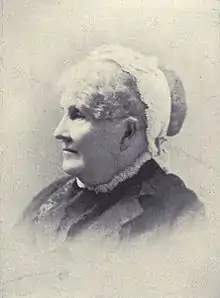Clarissa Chapman Armstrong
Clarissa Chapman Armstrong (May 15, 1805 – July 20, 1891) was an American missionary in the Hawaiian Islands and Marquesas Islands, from 1832 until 1847. She was part of the Fifth Company of missionaries sent to Hawaii by the American Board of Commissioners for Foreign Missions (ABCFM).


Early life
Clarissa Chapman was born and raised on a farm in Russell, Massachusetts. Her father was "crippled by rheumatism" and she remembered assisting him in farm work.[1] She trained as a teacher. Her brother was Reuben Atwater Chapman, a judge in Massachusetts.[2]
Mission work
Clarissa Chapman Armstrong sailed for Hawaii on a whaling ship in 1831, with her new husband, a Presbyterian minister.[1] They were part of the Fifth Company of missionaries sent to Hawaii by the American Board of Commissioners for Foreign Missions (ABCFM). She was pregnant for the entire six-month journey. Her first child, Caroline, was born two months after the couple arrived, in Honolulu. The couple with Benjamin and Mary Barker Parker were assigned as missionaries to Nuku Hiva in the Marquesas Islands from 1833 to 1834. Their first son was born there.[3] The failure of the Marquesan mission prompted them to return to Hawaii.[4] They lived at Wailuku on Maui from 1835 to 1840, and then moved to Honolulu.[2] Clarissa Chapman Armstrong taught literacy and Bible study classes for women. She did not always enjoy living among the native residents of Hawaii, writing that "Week after week passes and we see nothing but naked, filthy, wicked heathen with souls as dark as the tabernacles which they inhabit."[3]
Armstrong also made watercolor sketches of native Marquesan and Hawaiian people and places.[4][5][6] Eric Kjellgren and Carol S. Ivory states: "During her time in the Marquesas, Clarissa Armstrong painted four small watercolor portraits. They show details of tattoo and personal adornment, and though somewhat naive in their rendering of the human body nevertheless capture the dignity, humanity, and individuality of their subjects."[4] Subjects of her watercolor made in Hawaii included blind preacher Bartimea Puaʻaiki, Governor Hoapili of Maui and Queen Kalākua Kaheiheimālie.[7][8]
Richard Armstrong left mission work in 1847 to take secular employment as the Minister of Public Instruction under King Kamehameha III. Clarissa Armstrong no longer taught classes, but continued to hold Bible study meetings, now with other wives of Hawaiian chiefs and government officials, including Queen Kalama.[1] The Armstrongs lived in "the Stone House", a property of the Kingdom of Hawaii, which Clarissa kept as her residence after Richard's death in 1860. She sold the Honolulu house in 1881, and moved to San Francisco, California, to join her daughter's work at a Christian mission in that city's Chinatown.[1]
Personal life
Clarissa Chapman married Richard Armstrong on September 5, 1831, in Bridgeport, Connecticut. They had ten children. Their oldest son, William Nevins Armstrong (1835–1905) was Attorney General of the Kingdom of Hawaii from 1880 to 1882.[9] Their youngest son, Samuel Chapman Armstrong (1839–1893) was a Union Army general during the American Civil War and afterwards the founder of the Hampton Institute.[10] She became a widow when Richard died in a riding accident in 1860. She died on July 20, 1891, aged 86 years, from injuries sustained in a fall, in San Francisco. Her gravesite is in Oakland, California. Her papers are archived with Samuel Chapman Armstrong's at Williams College.[11]
References
- Helen W. Ludlow, "Clarissa Chapman Armstrong" in Hiram Collins Haydn, ed., American Heroes on Mission Fields: Brief Missionary Biographies (American Tract Society 1894): 255-298.
- Robert Francis Engs, Educating the Disfranchised and Disinherited: Samuel Chapman Armstrong and Hampton Institute, 1839–1893 (University of Tennessee Press 1999). ISBN 9781572330511
- Gary Y. Okihiro, Island World: A History of Hawai’i and the United States (University of California Press 2009): 98-104. ISBN 9780520261679
- Eric Kjellgren; Carol S. Ivory (2005). Adorning the World: Art of the Marquesas Islands. Metropolitan Museum of Art. pp. 60–63. ISBN 978-1-58839-146-9.
- Roger G. Rose (1980). Hawaiʻi, the Royal Isles. Bishop Museum Press. p. 173. ISBN 978-0-910240-27-7.
- Francis Greenwood Peabody (1920). Education for Life: The Story of Hampton Institute. Garden City, Doubleday. p. 56.
- Archer, Seth (26 April 2018). Sharks upon the Land: Colonialism, Indigenous Health, and Culture in Hawai'i, 1778–1855. Cambridge University Press. p. 210. ISBN 978-1-107-17456-6.
- Reynolds, Stephen (1989). Pauline King Joerger (ed.). Journal of Stephen Reynolds: 1823–1829. Ku Paʻa Inc. pp. 84, 87. ISBN 978-0-914916-80-2.
- "King Kalakaua's Tour: A Talk with his Attorney General" Hawaiian Gazette (October 12, 1881): 4. via Chronicling America

- Donald Spivey, Schooling for the New Slavery: Black Industrial Education, 1868–1915 (ABC-CLIO 1978): 7-15. ISBN 9780313200519
- Richard and Clarissa Chapman Armstrong, 1826–1890, in the Samuel Chapman Armstrong Papers, Williams College.
External links
- Clarissa Chapman Armstrong at Find a Grave
- Michael Colbruno, "Clarissa Chapman Armstrong (May 15, 1805 – July 20, 1891) One of first missionaries in Hawaii" Lives of the Dead: Mountain View Cemetery in Oakland (July 6, 2012).